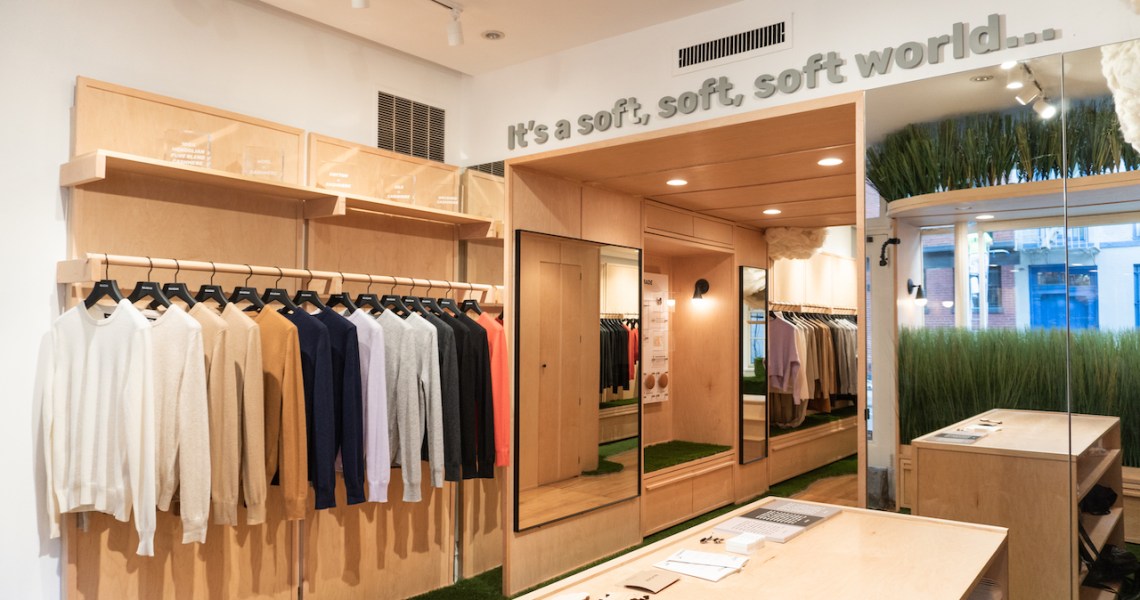For many direct-to-consumer brands, from Allbrids to Modern Citizen, opening physical retail locations is the next step in the growth journey. Not only can it grow sales and gain customers, but it often leads to upticks in e-commerce sales in surrounding areas. But getting into that world, from finding the space to staffing the stores, comes with challenges, especially among companies not well-versed in the world of retail.
When Naadam Cashmere secured $16 million in Series A funding last July, the brand’s CEO, Matt Scanlan, said he wanted to grow the brand and acquire new customers by opening retail locations in the U.S. and abroad in markets like Italy, Germany and the U.K. To make expansion into brick-and-mortar simpler, Naadam partnered with startup retail platform Leap on the brand’s two Manhattan locations.
Leap works with a number of DTC clients, including wedding-dress brand Floravere (which just opened its first permanent retail location in April) and shoe brand Koio, and takes on a lot of the big burdens that come with opening retail locations, from finding the perfect space to designing the space to heading up any necessary construction or instillation. Leap also scouts and hires all the staff who work in Leap-created retail locations.
“[Leap] absorbs all that risk, which is a ton of risk. They scout the locations, sign the lease. Then they cover all your capex expenses. They take that, they bring in an agency, they build the store. Still, I put out no money,” said Scanlan, on a recent episode of the Loose Threads podcast.
After the lease is signed, Naadam starts to flow inventory to the stores and work on store projections together. “Then we agree on a financial model — revenue share, management fee — so that they make money off of the store long-term, but that we make money, too,” he said.
Essentially, a partnership with Leap allows companies like Naadam to expand into retail without throwing too much money into it or incurring much risk as all. If Naadam starts selling out of one of Leap’s 1,000-foot retail locations in SoHo but finds after six months that sales are stagnant or the space isn’t getting a lot of foot traffic, Leap can cycle Naadam out of that store, bring another brand in and move Naadam to one of its other rented spaces. Or simply find a new location for the brand.
“The right brands want to focus on brand building, great product innovation, new collections, scaling supply chain and marketing. They don’t want to get bogged down by the details of what it takes to execute a great retail strategy. Leap is a platform they can use to build and operate stores at scale,” said Amish Tolia, CEO of Leap.
Ad position: web_incontent_pos1
Naadam first started to open pop-up shops in 2016, getting a sense of what it takes to build a physical presence for a relatively young (and small) brand. After partnering with Leap, the brand opened a SoHo location in October that only sells the brands $75 cashmere sweater, closely timed to the opening of a Bleecker Street location in September, which sells a larger range of product.
Naadam and Leap declined to share specifics on foot traffic to these locations or sales, but said the partnership does allow both parties to make smarter decision based on the data Leap gathers from these stores. It also allows brands to open retail locations on a much faster timeline, Tolia said. Leap can look at the brand’s e-commerce sales data to find what markets it should move to next. It also monitors in-store foot traffic and customer dwell time in front of certain products or fixtures to help improve store layout and displays.
Overall, the partnership is helping Naadam de-risk its major push into brick and mortar.
“Best-case scenario is we open up five or six stores, and I’m not shelling out millions and millions of dollars to do it. I’m focused on things I’m good at, and I let them do what they’re good at, and we scale together,” said Scanlan.


